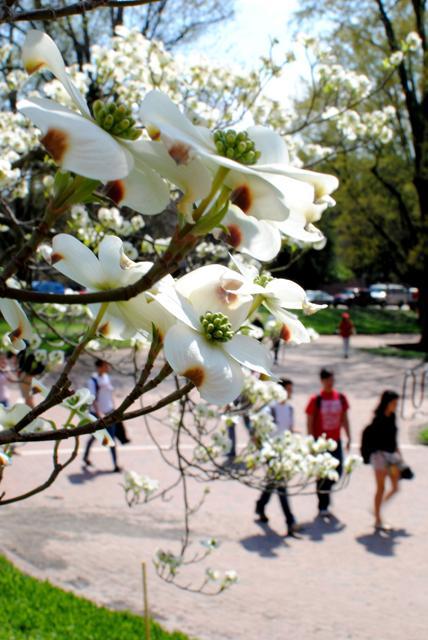The dogwood trees around campus blossom in the warm spring. However, the lovely white blooms of our state flower are plants under attack.
The culprits are dogwood anthracnose and powdery mildew, according to Thomas Ranney , professor of horticulture science and lead researcher for dogwood anthracnose prevention.
These diseases started about 20 years ago and affect different regions of North Carolina. According to Ranney , dogwood anthracnose affects dogwoods in the mountains, but powdery mildew affects dogwoods across the state. Ranney’s research dealt primarily with the prevention of dogwood anthracnose .
When a disease affects the human population, pathogens are spread by contact with sick people or contaminated surfaces. However, plant diseases are spread differently. According to Michael Benson, professor of plant pathology, there are three ways that dogwood anthracnose is usually spread: wind-borne spores, rain splash spores and insect interactions. Wind-borne spores are spread when infected spores from a diseased dogwood are blown onto a healthy dogwood. Rain splash spores spread when infected spores splash onto a healthy dogwood via rain. Finally, according to Benson, insects can also spread infected spores to healthy trees by coming in contact with diseased and healthy trees.
According to Benson, the main symptoms of an infected dogwood are lesions in the leaves and infected spores. If all of the leaves on the dogwood become infected, this could result in the death of the tree. However, as a defense mechanism, the dogwood will begin to sprout new sprouts to compensate for their foliage loss. The infected spores will then infect these new sprouts and cause a canker in the main stem when the fungus gets that far. This canker will ultimately kill the tree in one to two years.
“This disease only affects dogwoods,” Benson said.
Ranney initially became interested in his research because dogwood anthracnose and powdery mildew are both serious diseases.
“As a plant breeder, there was an opportunity to develop new trees for commercial and environmental value,” Ranney said.
His team has been working on dogwood immunization research for a decade, and has finally come up with a solution to the dogwood’s problem. According to Ranney , his team has investigated the different dogwood trees in the mountains and has found some of the most disease-resistant breeds. Ranney and his team isolated these superior specimens as the top, natural dogwood breeds, which will allow them to plant naturally disease resistant seeds in the future. The other part of Ranney’s research is focused on combining two superior breeds to form a superior hybrid.
“Through hybridization you can develop better traits,” Ranney said.
Dogwood anthracnose not only affects the health of the dogwood population, but a vital part of the North Carolina economy as well: the nursery industry. According to Ranney , 1.5 million dogwood trees are sold every year, bringing in $20 million annually. The majority of this industry is based in North Carolina, making dogwood anthracnose a major concern.
”[ Ranney’s research is] going to develop new types of dogwoods that are better than what we’ve currently got,” Ross Williams, executive director of the North Carolina Nursery and Landscape Association, said.
One of Williams’ main concerns is keeping the dogwood industry in North Carolina alive, and Ranney’s research is helping to do just that. According to Williams, Ranney’s research will allow the NCNLA to license new plants that North Carolina growers can produce more effectively. Therefore, Ranney’s research preserves both the dogwood tree and part of the North Carolina economy.
Next time you walk around campus, or anywhere in North Carolina for that matter, and see a flowering dogwood, remember the intensive research going into the preservation of our state flower.








